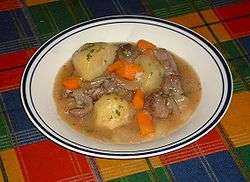Irish stew
 | |
| Type | Stew |
|---|---|
| Place of origin | Ireland |
| Main ingredients | Lamb, potatoes, carrots, onions, parsley |
|
| |
Irish stew (Irish: stobhach / Stobhach Gaelach)[1] is any variety of meat-and-root vegetables stew native to Ireland. As in all traditional folk dishes, the exact recipe is not consistent from time or place to place. Common ingredients include lamb, or mutton (mutton is used as it comes from less tender sheep over a year old, is fattier, and has a stronger flavour, and was generally more common in less-affluent times) as well as potatoes, onions, and parsley.[2] It may sometimes also include carrots. Irish stew is also made with kid goat.
| “ | Irish stew is a celebrated Irish dish, yet its composition is a matter of dispute. Purists maintain that the only acceptable and traditional ingredients are neck mutton chops or kid, potatoes, onions, and water. Others would add such items as carrots, turnips, and pearl barley; but the purists maintain that they spoil the true flavour of the dish. The ingredients are boiled and simmered slowly for up to two hours. Mutton was the dominant ingredient because the economic importance of sheep lay in their wool and milk produce and this ensured that only old or economically non-viable animals ended up in the cooking pot, where they needed hours of slow cooking. Irish stew is the product of a culinary tradition that relied almost exclusively on cooking over an open fire. It seems that Irish stew was recognized as early as about 1800.[3] | ” |
History
Stewing is an ancient method of cooking meats that is common throughout the world. However, the Celts did not possess their first bronze cauldrons, copied from Greek models, until the seventh century AD. After the idea of the cauldron was imported from Europe and/or Britain, the cauldron (along with the already established spit) became the dominant cooking tool in ancient Ireland, ovens being practically unknown to the ancient Gaels.[4] The cauldron, along with flesh-hooks for suspending the meat, eventually became preferred over the spit for feasting purposes, as evidenced by archaeological findings that indicate a predominance of flesh hooks over roasting spits in Ireland and Britain (Cunliffe, Barry; "Britain Begins"; 2012). Many food historians believe that goat was originally the meat of choice, eventually being supplanted by beef and mutton.[5]
The root vegetables and meat (originally goat) for the stew were then all in place, save for the potato. The introduction of the potato, originally a South American crop, did not occur until after the sixteenth century.
See also
References
- ↑ "Irish stew". téarma.ie – Dictionary of Irish Terms. Foras na Gaeilge and Dublin City University. Retrieved 18 Nov 2016.
- ↑ "Home Cooking: Traditional Irish Stew". Homecooking.about.com. 2012-04-10. Retrieved 2012-04-27.
- ↑ Davidson, Alan. (2006). Oxford Companion to Food. Oxford: Oxford University Press. (p. 409).
- ↑ "A History of Irish Cuisine". Ravensgard.org. Retrieved 2012-04-27.
- ↑ "How to cook an Irish stew". tribunedigital-chicagotribune. Retrieved 3 July 2015.
Bibliography
- Davidson, Alan & Jaine, Tom (2006) Oxford Companion to Food. Oxford: Oxford University Press. ISBN 9780192806819
| Wikibooks Cookbook has a recipe/module on |